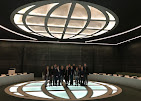Topos 94/2016 – URBAN PLANNING – Charte des Paysages, Bordeaux/FR
ADAPTIVE PLANNING
Bordeaux’s open space has undergone
continuous transformation since 2001. The urban area, however, has not been
completely connected to this surrounding green space. In its search for the
development of a connecting element, the city turned to landscape architects
Michel Desvigne Paysagiste. Two projects completed in 2015 are a direct result
of the office’s master plan: the new football stadium “Stade Atlantique” and
the riverbank park “Parc aux angéliques”.
Text Michael Koller
Translation David Skogley
The project of enhancing Bordeaux’s
green open space was originally conceived as part of the Green Plan in 2001. At
that time public plazas in the city centre were continuously being rebuilt and
expanded. At the same time, three new tram lines were also built. The general urban
area, however, was still rather undefined and difficult to grasp in a spatial
sense, as the historic city centre still had
numerous vacant lots and there was a lack of connections between green open
space areas and the plazas.
In 2005 Paris landscape architects
Michel Desvigne Paysagiste were commissioned by the city of Bordeaux to develop
a plan of how to improve and enlarge urban open space. The office then drafted
guidelines and developed tools for a unified design concept, a Charte des Paysages,
or landscape charter. In association with this concept, they developed a
concrete
planning culture together with the
city’s office for Urban Ecology, Environment and Open Space Planning, which
also took over construction of the projects.
The method developed consisted of a series of case studies: The office analysed approximately one dozen projects and investigated each area according to its spatial unity, borders, typologies, levels, soils and open space structure. Trial plantings on site were undertaken as a result of this empirical approach in order to test the spatial, aesthetic, functional and ecological impacts.
These methods replaced traditional regulatory planning documents and led to numerous changes and adjustments in existing development plans. They allowed for increased flexibility during the implementation of large-scale interventions, which needed to be achieved under the restraints of very limited financial resources.
The method developed consisted of a series of case studies: The office analysed approximately one dozen projects and investigated each area according to its spatial unity, borders, typologies, levels, soils and open space structure. Trial plantings on site were undertaken as a result of this empirical approach in order to test the spatial, aesthetic, functional and ecological impacts.
These methods replaced traditional regulatory planning documents and led to numerous changes and adjustments in existing development plans. They allowed for increased flexibility during the implementation of large-scale interventions, which needed to be achieved under the restraints of very limited financial resources.
 |
| The new Stade Atlantique football stadium was designed by Herzog & de Meuron and is located between the city’s wealthy green belt and a number of green areas near the city centre. © MDP |
Stade Atlantique Football Stadium.
The redesign of the open space
around Herzog & de Meuron’s new Stade Atlantique football stadium to the
north of the city centre also began with a variety of test plantings, which
served as prototypes for the later design of the stadium’s forecourt. Before construction of
the football stadium, which was completed in 2015 in time for the upcoming
European Football Championship, began, the Parc Floral’s existing car park was
extended, planted and renaturalised.
The new football stadium is located
between the city’s wealthy green belt and a number of green areas near the city
centre. The entire area is part of a landscape design concept developed for
Bordeaux’s northern ring road. This landscape is structured by a strict
geometric system of drainage canals built during the 17th century by Flemish
master builders in order to recover additional
agricultural land. The canals are often lined by rows of poplars.
The landscape architects were inspired by this historic element and added green verges with rows of trees to the paved surfaces they created. In doing so, the verges were cut into the original asphalt. The soil placed in the trenches they created was mixed with gravel in order to increase stability and then planted with both coniferous and deciduous trees. The linear arrangement of the trees in the parking areas is at times broken up by asymmetrical groups of trees planted between them.
The surface, which was originally completely impervious, was thus made more permeable.
 |
| The stadium’s car park was extended, planted and renaturalised. © MDP |
The landscape architects were inspired by this historic element and added green verges with rows of trees to the paved surfaces they created. In doing so, the verges were cut into the original asphalt. The soil placed in the trenches they created was mixed with gravel in order to increase stability and then planted with both coniferous and deciduous trees. The linear arrangement of the trees in the parking areas is at times broken up by asymmetrical groups of trees planted between them.
The surface, which was originally completely impervious, was thus made more permeable.
The measures used proved to be
relatively inexpensive as well: The system of tree rows, green verges and
individual groups of trees uses simple elements to connect the stadium’s forecourt
with the parking area and the existing hedges, groups of trees and habitat
edges on the site’s periphery. [...]
Read more in Topos 94 - City Visions
Read more in Topos 94 - City Visions







